In earlier articles I discussed my hunts for Rocky Mountain Bighorn Ram and Ewe on Pikes Peak. I mentioned that it is normally difficult to get drawn for a Ram license. After my successful sheep hunts, I decided to try my luck in the drawing for a Rocky Mountain Goat license, which was even more difficult than the sheep drawing. Lady luck was again on my side, and I was successful on my second application. My Goat management unit was on Gladstone Ridge, elevation about 12,500 feet along the Continental Divide mountains more or less west of Buena Vista, Colorado, about 4 miles south of Mount Yale, elevation 14,196 feet.
In my research and in discussion with Colorado Division of Wildlife (now Colorado Parks and Wildlife or CPW) personnel, I was able to determine where the goats lived within my hunting unit. The nearest public road was about three miles from the primary goat habitat. The public road would take me to timberline. I decided to make a scouting trip to determine exactly where the goats lived and the easiest way to get there.
On a Saturday in early July 1992, my friend, Dick Duncan, and I camped out in my pickup topper near timberline on the nearest public road to the goat habitat. Dick and I had met while we attended graduate school at Stanford University and had served in Vietnam at the same time where we visited each other. Dick had recently retired from the Army and he and his wife Betsy settled in Monument, Colorado near Colorado Springs where my wife Jean and I lived.
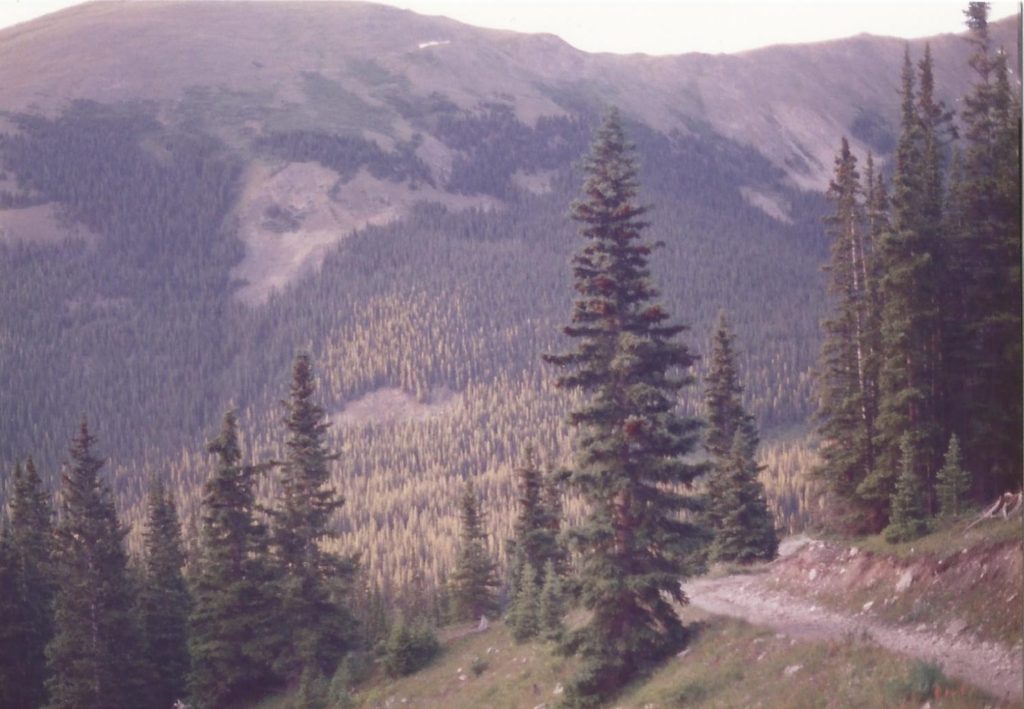
Heading to Timberline on Public Road toward Gladstone Ridge.
Early that Sunday morning we began our 3-mile hike to the area where the goats lived. It was a fairly easy hike because the ridge we were on was more or less level and we did not have to climb any hills or other obstacles.
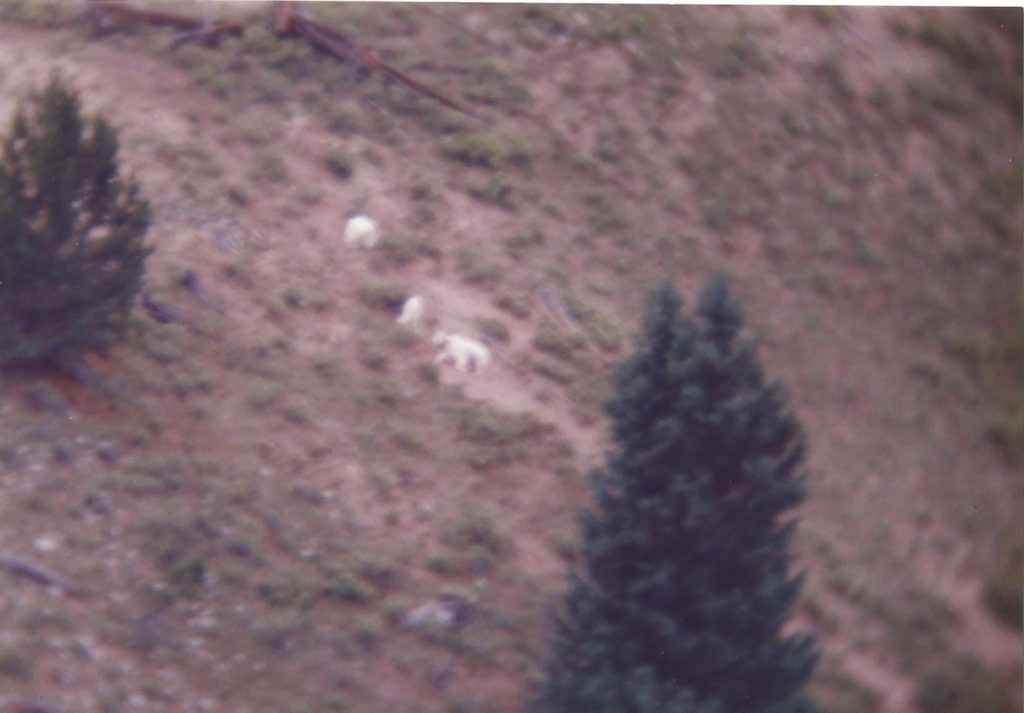
Three Goats on Nearby Hillside.
We were able to find where the goats lived and observed several goats in the area. We carefully inspected the area and found a good observation point for my planned hunting spot.
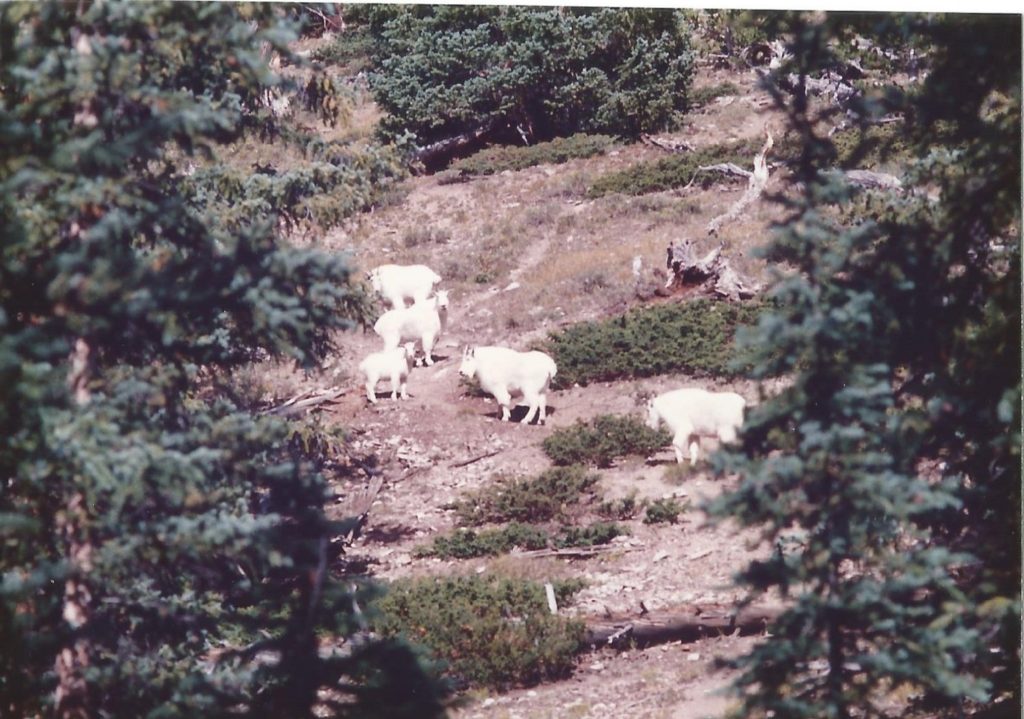
Four Adult Goats and one Kid near our Observation Point.
We determined that this was a good area to conduct my actual hunt provided we could find a better way to access the area. After spending about two hours of observing the goats and getting a good lay of the land, we began our return 3-mile hike to my truck. We were blessed with good weather all day with no lightening which is always a threat when hiking above timberline.
I had purchased a topographical map of the area and was able to mark the goat habitat on the map. Now I had the task to locate a shorter way to get to the goats’ home rather than making the 6-mile round trip hike from the public road.
I purchased additional topographical maps of the area surrounding the goat habitat. Studying the maps, I discovered an abandoned mine about 2000 feet directly below the goats’ home. Access to the mine was a narrow road cut along the side of the mountain from the public road. The access road was about one foot wider than my full-size GMC short bed 4 x 4 pickup. On the downhill side of the road was a sheer drop off of several hundred feet.
Two weeks after our first scouting trip, Dick and I decided to access the goats’ home from the mine. Dick walked in front of my truck, removed loose rocks from the road and guided me around the side of the mountain, ensuring that my truck and I would not fall off the side of the road. Dick told me that he felt much safer walking on the road than riding in the pickup with me. We made it to the abandoned mine where we were able to park my truck with enough room to turn the truck around.
We then climbed up, (sometimes on our hands and knees,) the side of the mountain to where I had marked the goat habitat on my topographical map. It was a very steep climb, but we had no sheer cliffs. Since the area was wooded, we were able to pull ourselves up between trees in the steepest portion of the climb. We saw some goats in the area just as we had our first scouting trip. It was decided that that this was the route we would take for the actual hunt.
On our way back down to the truck, we found a relatively level area about 300 feet below the goat habitat. We decided that this was an ideal spot to set up our camp for the actual hunt.
Now that I had a plan for the actual hunt, I located an experienced taxidermist who would shoulder mount my trophy. His studio was in Woodland Park, Colorado located up the mountain west of Colorado Springs, about 100 miles from my hunting area. The taxidermist told me that it would be critical that I cool out the cape and get the cape of the goat to him as soon as possible, preferably within 12 hours after the kill, or else the hair would begin falling out of the cape. Since we did not have cell phones in those days, I located a pay telephone In Buena Vista, Colorado which was on my route back to Woodland Park. I estimated that it was about a two-hour drive from Buena Vista to Woodland Park.
Now that I had everything planned, I was ready to implement my plan.
One week before my hunt, Dick and I made another trip to the old mine to pack in as much of our camp as we could. We took a 3-day supply of food–Meals Ready to Eat (MREs), several gallons of water, a two-man tent, propane lantern, propane gas cylinders and a one burner propane stove. We also took a small pick and shovel to dig a hole to bury our supplies in plastic bags. Once we got to the camp site, we buried our equipment, food and water in plastic bags and covered it with dirt to protect it from varmints and bears.
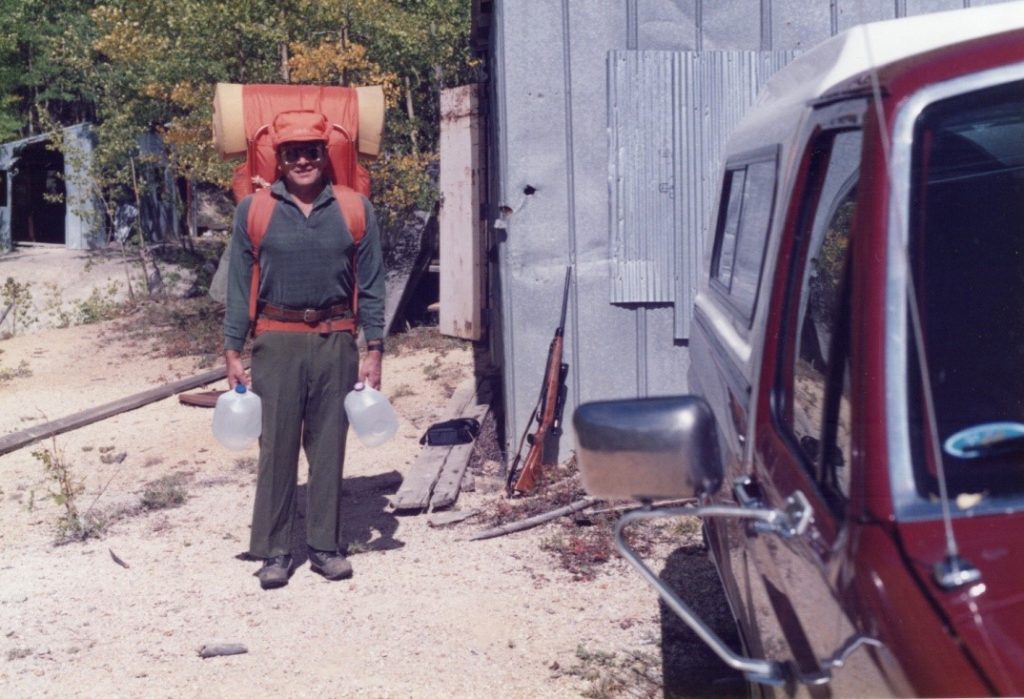
Dick Duncan with Loaded Backpack and Bottles of Water Ready to Climb to our Camp Site.
On the day before the hunt, we made our final trip to the old mine. We back packed the rest of our equipment (Remington 700 BDL 30.06 rifle, binoculars, spotting scope, butchering equipment, sleeping bags and warm clothes) and headed up the side of the mountain. Once at the camp site, we uncovered our buried supplies and set up our tent. After a good hot supper, we got into our sleeping bags and settled down early to be ready for the big day.
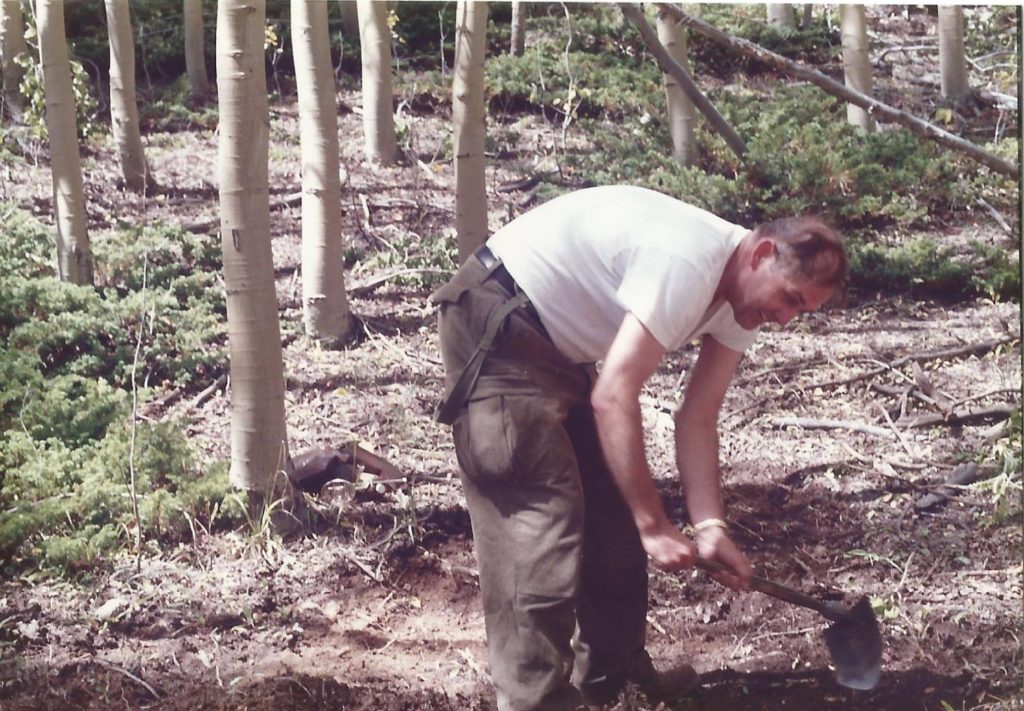
Preparing our Camp Site.
During the night we could hear animals making noises close by, but we did not investigate. It might have been a black bear who are known to be in this area. We got up early, had a good breakfast, and then completed the 30-minute hike up to the place where the goats lived. Shortly before daylight, we were in my ground blind I had selected on my first trip to the area several weeks earlier.
Shortly after daylight, the beautiful sunrise began a bright sunny day. Because their solid white coats make them stand out in the rocky areas around us, we spotted goats, some near, some far. We observed two especially large Billie goats about 1/2 mile away on the next ridge. There was a very deep canyon between us and those goats. We decided that it was impossible to get to them safely. It was nearly impossible to retrieve one should I kill it on that ridge.
We then concentrated on several goats that were more readily accessible. After studying those goats with my spotting scope, I decided to take the largest one in the group. Getting into a good shooting position with a solid rest, I squeezed the trigger on my Remington 700 BDL 30.06 and let the Nossler Partition 180 grain bullet do its job. The goat dropped in its tracks.

A Proud Hunter with his Rocky Mountain Goat Trophy.
Of course, we had to take time to get a few photos of the kill. I field dressed the goat and carefully removed the cape, leaving it attached to the head ready for the taxidermist. I then butchered it in place. We put the meat into plastic bags and placed it into our back packs, leaving the carcass for the predators. We did take time to hang up the cape inside out to allow it to cool out.
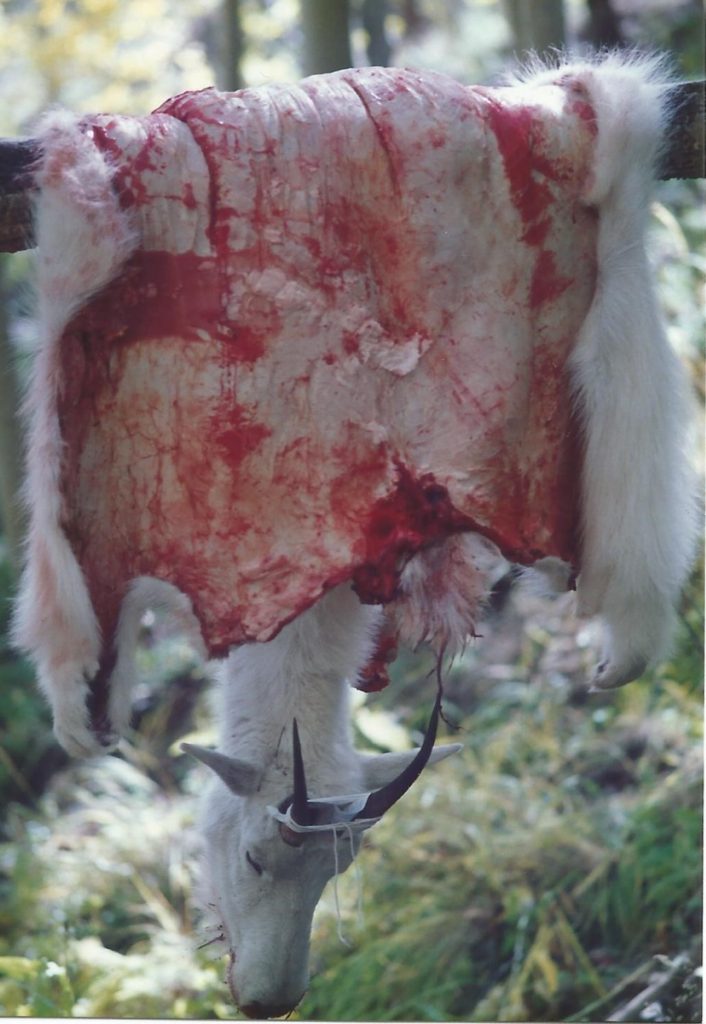
Cooling Down the Cape.
I then put the soft white cape around my neck, and we headed down to our camp site. There we took as much of our equipment as we could and headed down the slippery slope to my truck at the old mine. We unloaded the meat and other equipment into the truck. I was not feeling well that day and felt that I could not make another trip up the mountain that day to retrieve the rest of our camping equipment. One person could retrieve all of the rest of the equipment so Dick said he would make the trip alone and I would remain with the truck.
After a little rest Dick began the climb back up to our camp site to retrieve the rest of our equipment. Since Dick was in excellent condition it did not take him long to return. By late afternoon Dick was safely back at the old mine and we had all our equipment and the goat loaded in my truck.
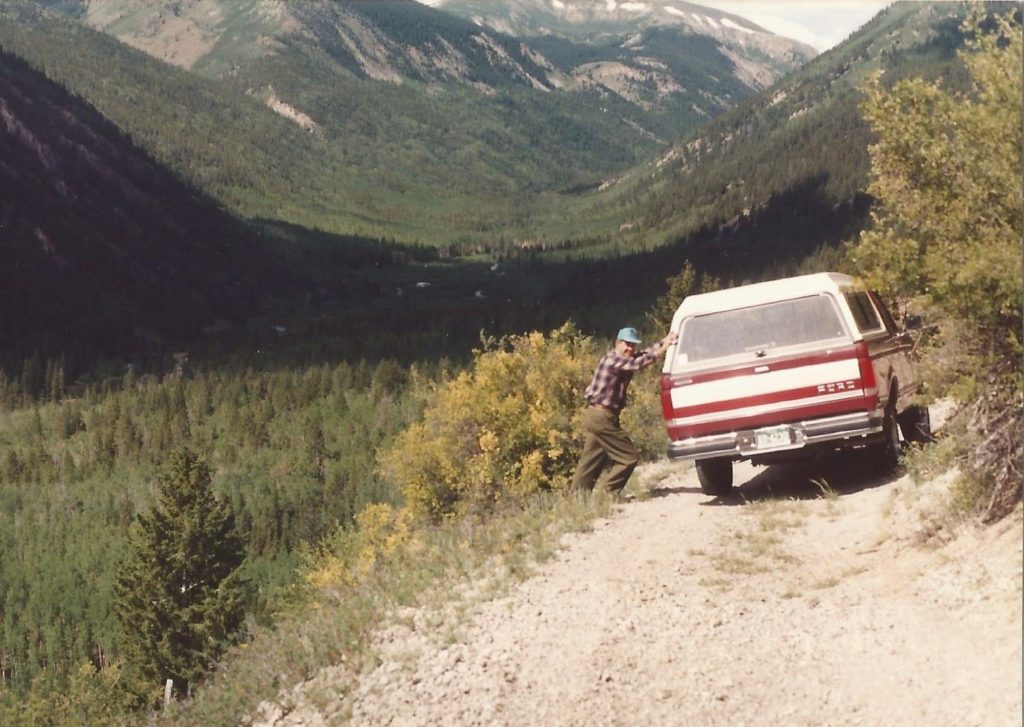
Heading for Home after a Successful Rocky Mountain Goat Hunting Adventure.
Dick then once again guided me and my truck down the treacherous narrow road from the mine to the public road.
We got to the nearest payphone in Buena Vista by about 6 PM and called the taxidermist. He agreed to meet us at his shop in Woodland Park at 9 PM. After the cape and head were safely in the hands of the taxidermist, we got home at about 11 PM.
Mission accomplished. I now had my three alpine trophies– my Rocky Mountain Bighorn Ram, my Rocky Mountain Bighorn Ewe and finally my Rocky Mountain Goat. Three greats, but entirely different, adventures were now completed.
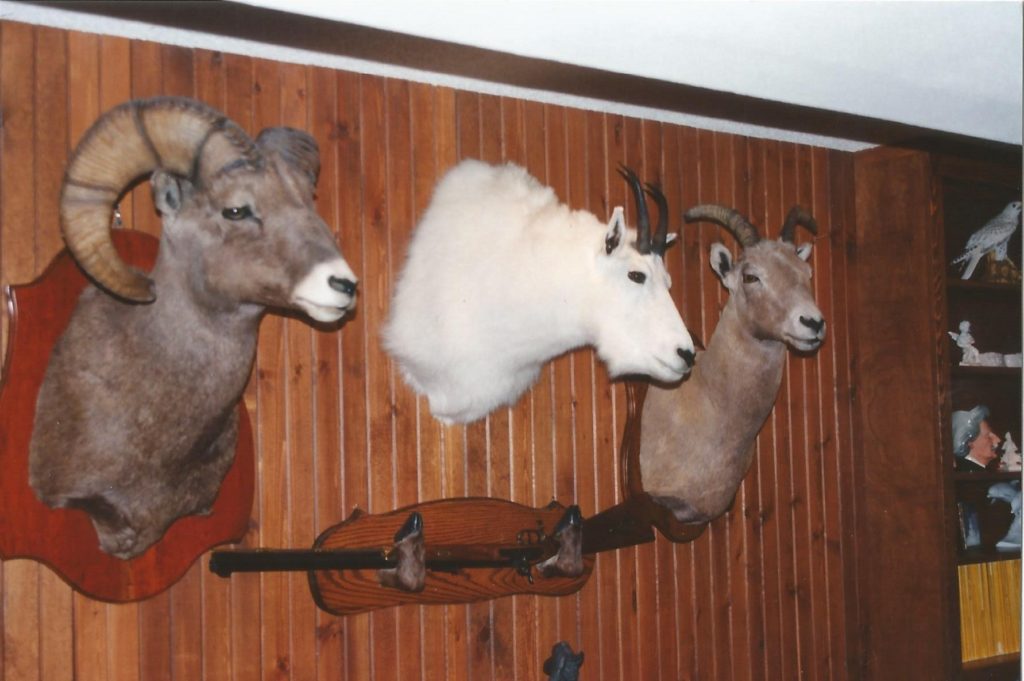
My Goat, Flanked by my Bighorn Ram and Ewe, in my Rec Room in Colorado Springs.
I am deeply indebted to my hunting partner, Dick Duncan, Colonel, US Army, Retired, who assisted me during all of my trips related to my goat hunt. Without his help, I could not have accomplished the successful goat hunt adventure. Thanks, Dick!
Thanks also go to the Colorado Parks and Wildlife for giving me the opportunity to hunt the three majestic alpine animals in their native habitats. I was very lucky in the drawings for the licenses. Many of my Colorado hunting buddies were not as fortunate in their attempts to obtain licenses and did not experience the joys of successfully hunting these animals as I did.
Dick and Betsy have continued to live in Colorado after Jean and I moved in 1998 from Colorado to our native Texas, where most of our families live. We built our retirement home in Garden Ridge near San Antonio, Texas. I continued to come to Colorado to hunt elk for the next 21 years. In two earlier articles on this website, I discussed some of my memorable Colorado elk hunts.
Dick volunteers for the Colorado Parks and Wildlife, conducting surveys and other tasks related to wildlife management throughout Colorado. He visited the area where we had conducted my Rocky Mountain Goat hunt and noted that the goats no longer live in that area–they have moved further north. The goat hunt I had in 1992 can no longer take place in 2021. Their new home might be even more difficult to access than their home was when I hunted them.
After Jean passed away in 2018, I moved to the city of New Braunfels, Texas, about twenty miles north of Garden Ridge. In 2021, all three trophies of my alpine animals are proudly displayed, with many of my other mounted trophies, in my living room in New Braunfels.
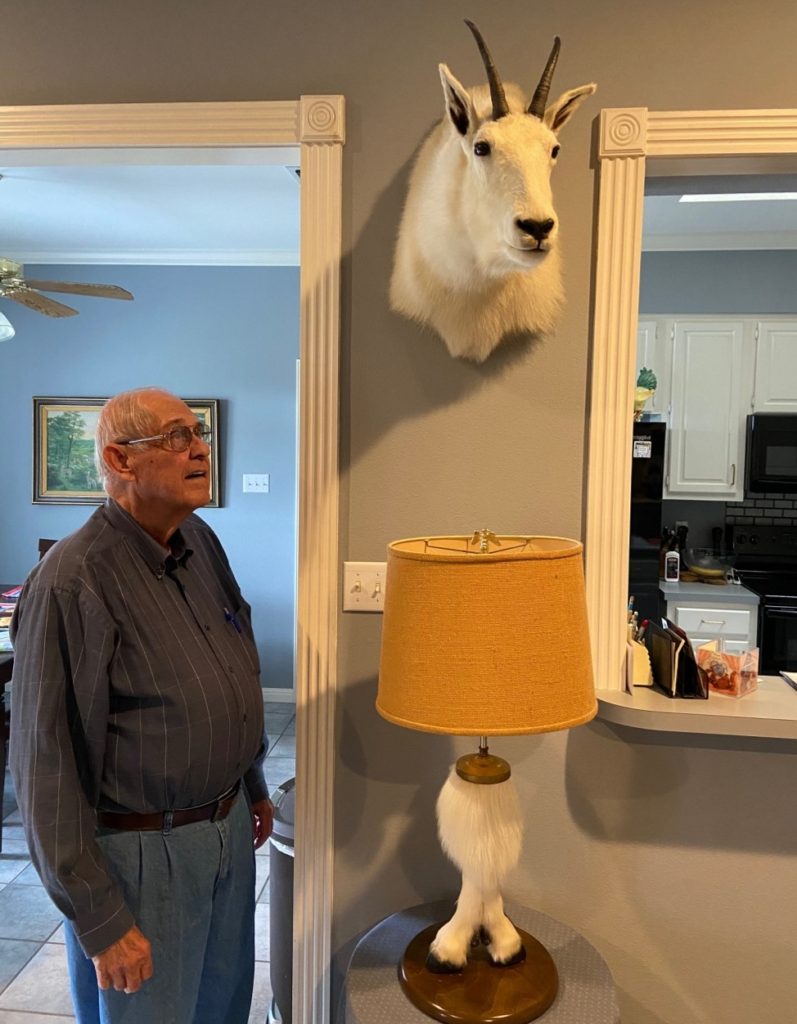
Admiring my Rocky Mountain Goat in my New Braunfels. Texas Home. Note the Table Lamp with the Front Legs of the Goat.
In the photo with the three trophies, note the remainder of the cape, including the tail, on the chair next to me. This part was not used on the shoulder mount and makes a wonderful throw rug. With the shoulder mount, the table lamp and the throw rug, very little of the cape was wasted. Today, looking at these items from the goat helps me to re-live my Rocky Mountain Goat Hunt almost 30 years after my encounter with the goat on Gladstone Ridge in the beautiful mountains on the Continental Divide high above Buena Vista, Colorado.
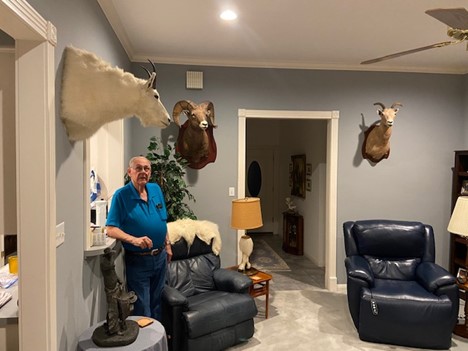
My Three Colorado Alpine Trophies in my New Braunfels, Texas Home in 2021.
Clarence Scheel
Latest posts by Clarence Scheel (see all)
- HUNTING REHBOCK (ROEBUCK) IN GERMANY – September 27, 2022
- HUNTING FALLOW DEER (DAMHIRSCH) IN GERMANY – September 23, 2022
- HUNTING ROCKY MOUNTAIN GOAT NEAR BUENA VISTA, COLORADO – October 10, 2021
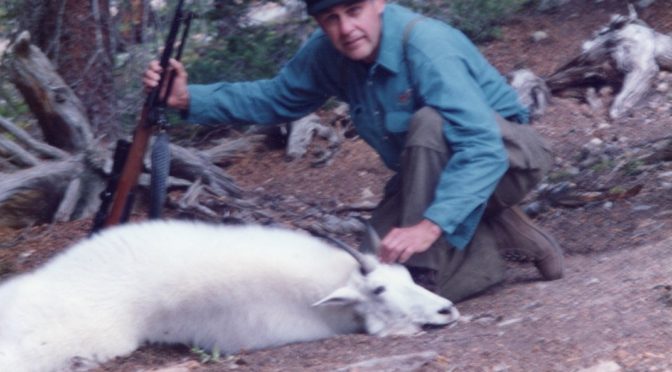
Leave a Reply